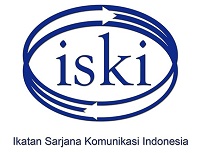Rhetorical Analysis of Hate Speech: Case Study of Hate Speech Related to Ahok’s Religion Blasphemy Case
Abstract
The discussion about hate speech is not something new. However, recently it becomes phenomenon that widely spoken. As something that naturally comes out as a human nature. Nowadays hate speech tends to be harmful because it is supported by new media such as online media and social media. This research try to discuss about hate speech related to religion blasphemy accusation that drags, Basuki Tjahaya Purnama known as Ahok into jail. This paper used qualitative method and rhetoric analysis to analyze the hate speech in online media news related to Ahok’s case. The results are, hate speech came from content posted in website such as online political opinion and news. From ethos aspect, most of the hate speech neglected the ethos aspect which provides the credibility and trustworthiness of the source.; from the pathos aspect, the author of the news are choosing words that triggered anger and negative emotion from its audience; from the logos aspect, most of the hate speech draws it’s readers to logical fallacy due to the lackness of facts of its conclusion claim. The Hate speech rhetoric neglects the ethos and logos aspects and it mostly rely on pathos aspect to persuade its readers for hating.
Keywords
Full Text:
PDFReferences
-. (-, - -). Why is Rhetoric Required? Retrieved June 2, 2017, from Collage of Liberal Arts and Sciences The University of Iowa:https://clas.uiowa.edu/rhetoric/ about/why-is-rhetoric-required
-. (-, - -). Why is Rhetoric Required? Retrieved June 2, 2017, from Collage of Liberal
Arts and Sciences The University of Iowa: https://clas.uiowa.edu/rhetoric/ about/why-is-rhetoric-required
Agence France-Presse. Jakarta protest : Muslims Turn Out in Force Against Christian Governor Ahok. Retrieved June 2, 2017 from https://www.theguardian.com/world/2016/dec/02/ jakarta-protests-muslims-againstchristian-governor-ahok
Ambardi, K., Parahita, G., Lindawati, L., Sukarno, A., & Aprilia, N. (2016). Mapping Digital Media: Indonesia . Open Society Foundation .
APJII. (2016). Penetrasi & Perilaku Pengguna Internet Indoenesia, Survey 2016. Polling Indonesia & APJII.
Axelrod, R. B. (1999). Reading Critically, Writing Well: A Reader and Guide. New York: Bedford/St. Martins.
Boundless. (-, - -). Modes of Persuasion: Ethos, Pathos, and Logos. Retrieved June 2, 2017, from boundless. com: https://www.boundless.com/ writing/textbooks/boundless-writingtextbook/writing-an-effectivepaper-235/building-your-paper-239/ modes-of-persuasion-ethos-pathosand-logos-42-7909/
Cohen-Almagor, Raphael. (2011). Fighting Hate and Bigotry on the Internet. Policy & Internet. Vol.3: Iss.3, Article 6 , (1-26)
Etikan, Ilker., Musa, Sulaiman Abubakar., Alkassim, Rukayya Sunusi. (2016). Comparison of Convenience Sampling and Purposive Sampling. American Journal of Theoretical and Applied
Statististics.Vol 5 (1) : 1-4
Flew, T. (2008). New Media. South Melbourne: Oxford University Press
Hansen, B. (2003, October 20). Ethos, Pathos, Logos and the NTSB. Retrieved June 2, 2017, from http://intrans.iastate. edu: http://intrans.iastate.edu/mtc/ documents/studentPapers/2003/Brett_ Hansen.pdf
International, A. (2014). Prosecuting Beliefs Indonesian’s Blasphemy Laws.
London: Amnesty International Ltd.
Mshvenieradze, T. (2013). Logos Ethos and Pathos in Political Discourse. Theory and Practice in Language Studies , 3 (9), 1939-1945.
News Desk, J. P. (2017, January 28). Indonesia is a religious country’: TNI commander. Retrieved June 2, 2017, from www.thejakartapost.
comm: http://www.thejakartapost. com/news/2017/01/28/indonesia-is-areligious-country-tni-commander.html
Nurdin/Zunus. (2016, October 14). Banyak Media Provokatif, Bimas Islam Kemenag Undang Jaringan Media Islam. Retrieved June 2, 2017, from www.nu.or.id: http://www.nu.or. id/post/read/72000/banyak-mediaprovokatif-bimas-islam-kemenagundang-jaringan-media-islam
Selzer, Jack. (2004). Rhetorical Analysis : Understanding How Texts Persuade Readers. In Bazerman, Charles., Prior Paul. What Writing Does and How It Does It. (pp. 279-307). New Jersey: Lawrence Erlbaum Associates, Inc., Publishers
Sternberg, Robert J., Sternberg Karin. (2008). The Nature of Hate. United States of America: Cambridge University Press
Tifa, y. (-, - -). Upaya Deradikalisasi Agama Lewat Media. Retrieved June 2, 2017, from www.tifafoundation.org: http://www.tifafoundation.org/upayaderadikalisasi-agama-lewat-media/
Whillock, R. K. (2000). Ethical Considerations of Civil Discourse: The Implication of The Rise of “Hate Speech”. In R. E. Denton.Jr, Political Communication Ethics An Oxymoron? (pp. 75-90). Westport: Praeger Publisher.
DOI: https://doi.org/10.29313/mediator.v11i1.3119
Refbacks
- There are currently no refbacks.

This work is licensed under a Creative Commons Attribution 4.0 International License























